There is something unique about the way each of the seven “letters” of Revelation begin.
Each of the “letters” to the named churches of Asia in Revelation 2-3 differs from a letter in being essentially an oral statement and in not making reference to particular individuals. The “letters” to the seven churches (Rev. 2:1, etc.) are edicts and open, as here, with the characteristic verb of declaration, λεγει [says] (Horsley, New Documents Illustrating Early Christianity, I:40. Horsley points to numerous examples of this use during the Roman Imperial period, as do major lexicons.
The terminology used sets up the great battle of the book. It is Lord God versus Lord Caesar or, to say it another way, King Jesus versus the king of Rome.
Too many times I have heard the statement made something like this: “I don’t know what this biblical passage meant to the original readers, but here is what it means to us.” Such a statement frightens me. If I do not understand what a text meant to the original readers, how can I know what it is supposed to mean to me? Understanding a text in its original context allows one to make an application of it to his or her own life situation.
What problem did the church at Pergamum face? Certainly they faced the problems we have already mentioned, the worship of pagan gods and the worship of the Roman emperor. Conditions were extremely difficult for the Christians at Pergamum (Rev. 2:12-17. The church is said to dwell where Satan’s throne is (2:13). In spite of this the saints were holding fast to the name of the the risen savior even in the days of Antipas who was martyred.
The photo below was made at the Askelpium. From there we see the citadel of the ancient city.
What is the meaning of the expression “where Satan dwells”? E. M. Blaiklock, Cities of the New Testament, finds three strata of paganism at Pergamum.
- Associated with the worship of snakes and handling of reptiles. There was a great center involving the worship of Asklepios, the god of healing, at Pergamum. The serpent was the symbol of Asklepios.
- The worship of Zeus and Athena. There were temples to each of them at Pergamum.
- The Imperial cult during the Roman period.
When we see a statue of Asklepios we see a serpent entwined around his staff. The temple of Zeus has been reconstructed in the Pergamum Museum in Berlin, Germany. Some of the reliefs from the temple shows battles involving giants whose legs were massive serpents. The Christians would be familiar with the Old Testament account of the fall of man and the part that the serpent played in it. The book of Revelation presents the great dragon as “that ancient serpent, who is called the devil and Satan, the deceiver of the whole world” (Rev. 12:9). The woman of Revelation 12:14-15 was given wings of a great eagle in order to fly into the wilderness to be cared for, like ancient Israel was, for a time, times, and half a time. See also Revelation 20:2 that tells of the binding of “the serpent of old, who is the devil and Satan.”
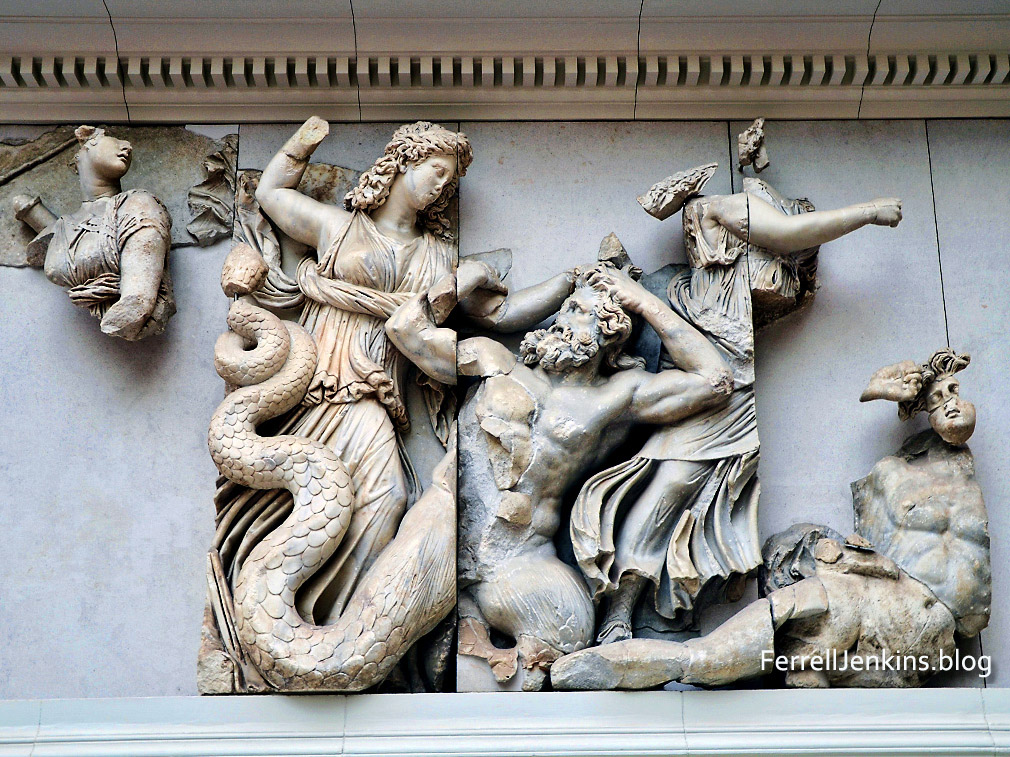
Reliefs associated with the Zeus Altar at Pergamum show giants with legs of serpents. Photo by Ferrell Jenkins.
Much of the symbolism of the book of Revelation may be unfamiliar to modern readers, but I strongly contend that it was not unfamiliar to the original readers of the book. Even the coins they used portrayed some of the same symbolism.
In the garden of the museum at Bergama, the modern Turkish city at Pergamum, an inscription naming Pergamum as twice Neokoros (temple keeper or warden) of the Imperial cult. The city was the first of Asia Minor to be awarded a temple. This temple was erected to Augustus in 29 B.C. The second temple was erected to Trajan (A.D. 98-117). A third temple was erected to Caracalla (A.D. 211-217).
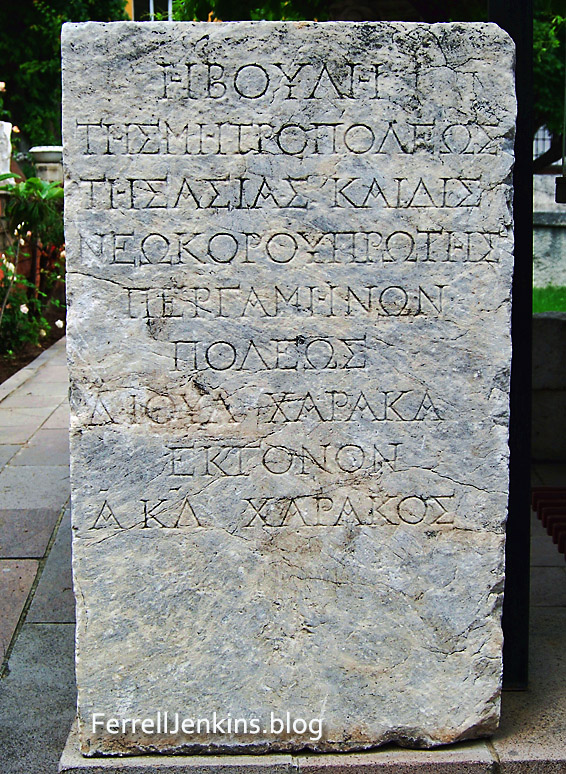
Inscription in the garden of the Bergama Museum naming Pergamum as twice Neokoros (see fourth line: ΝEΟΚΩPOY) of an Imperial temple. Photo by Ferrell Jenkins.
Ruins of the Trajan temple have been partially reconstructed at Pergamum. Several times I have worked with churches meeting in rental halls or small buildings. Occasionally someone asks, “where is your church [building]”? When I told them where we met they might say that their church was the large magnificent one a block from the city square…. One can imagine how the saints at Pergamum might have felt under similar circumstances.
Some of the saints at Pergamum held to the teaching of the Nicolaitans. Some at Ephesus hated the works of the Nicolaitans (Rev. 2:6). I know no more about this group than you can read in dozens of commentaries. But there were some in the church “who hold the teaching of Balaam, who taught Balak to put a stumbling block before the sons of Israel, so that they might eat food sacrificed to idols and practice sexual immorality” (Rev. 2:14 ESV). These were the requirements to be placed on Gentile converts (Acts 15:29; 21:25). John had urged Christians to “not love the world or the things in the world” (1 John 2:15-17). This, he said, includes the desires of the flesh, the desires of the eyes and the pride of life. I hear some putting all of this under the term worldliness. Adding sexual immorality to the eating of food sacrificed to idols definitely introduces our third problem faced by the Christians of the Gentile world. Paul’s discussion in Romans 1:18-32 and in the first epistle to the Corinthians provides more insight into the problem (see 1 Corinthians 6:9ff. and chapter 8).
An important episode in the history of Israel involved Balaam (Numbers 22-25; 31). He is known from
an 8th to 6th century B.C. Aramaic inscription found at Deir-Alla, Jordan, in 1967. Deir Alla is identified with biblical Succoth, the place where Jacob built a house for his family and shelters for his livestock (Genesis 33:16), by some scholars. Others say it is the site of Penuel where Jacob wrestled with the angel (Genesis 32:25-32). I am inclined to the first view, but that is not why we are mentioning the site.
In 1967 Dutch archaeologists led by Prof. H. J. Franken, found a fallen plaster wall containing a reference to the seer Balaam son of Beor. For some reason Balaam continued to be a significant influence to some in the area. See Franken’s entry in the Anchor Bible Dictionary and Lemaire’s article in Biblical Archaeology Review 11:05 Sept./Oct 1985. This is slightly aside from our main purpose here, but it illustrates the illumination provided by archaeological discoveries.
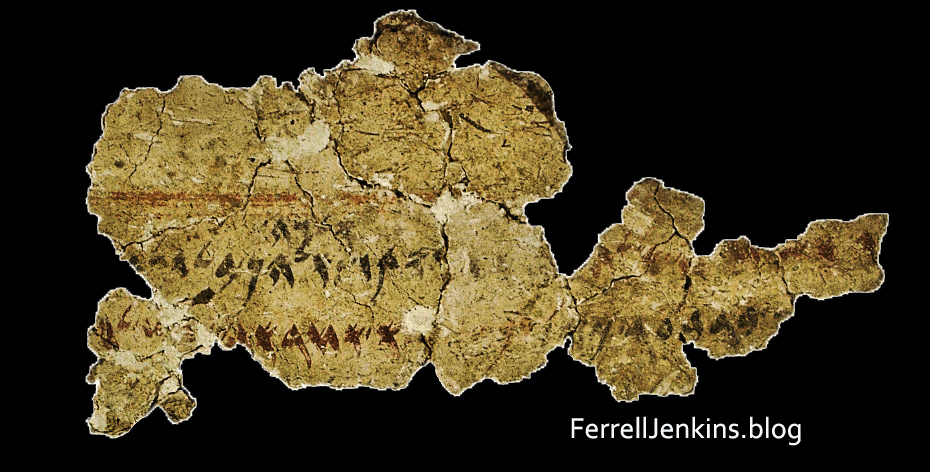
Inscription from Deir Alla showing name of Balaam. The name of the prophet is on the line above our blog name. Photo by Ferrell Jenkins in the Amman Archaeological Museum.
The problem here is that of compromise with religious error and sexual immorality. Paul refers to the Old Testament episode (Numbers 22-25) but does not call Balaam by name (1 Cor. 10:8). G. B. Caird (A Commentary on the Revelation of St. John) says Balaam is “the father of religious syncretism.” Earlier we stated that the Christians were not persecuted because they worshiped Christ, but because they would not worship the Emperor. Like Paul and John, the apostle Peter commanded the Christians to whom he wrote to keep their conduct among the Gentiles honorable (1 Peter 2:11-25).
The lesson from this episode in the account of Balaam and Balak is to get the people of God involved in the worship with the the pagans and in the immorality associated with it. I would say that it seems to work with most of the people most of the time.

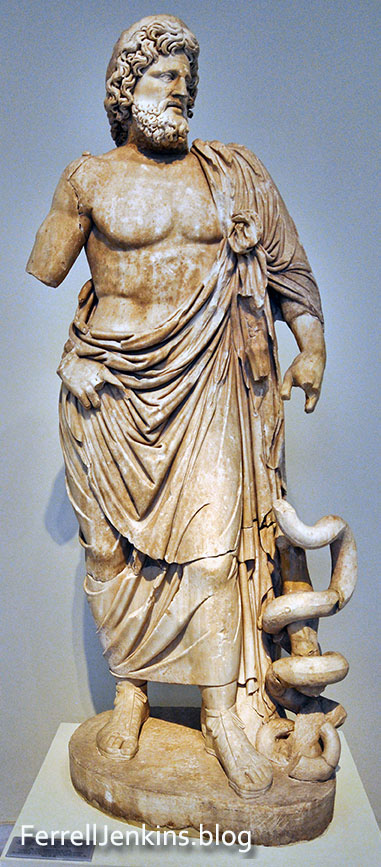

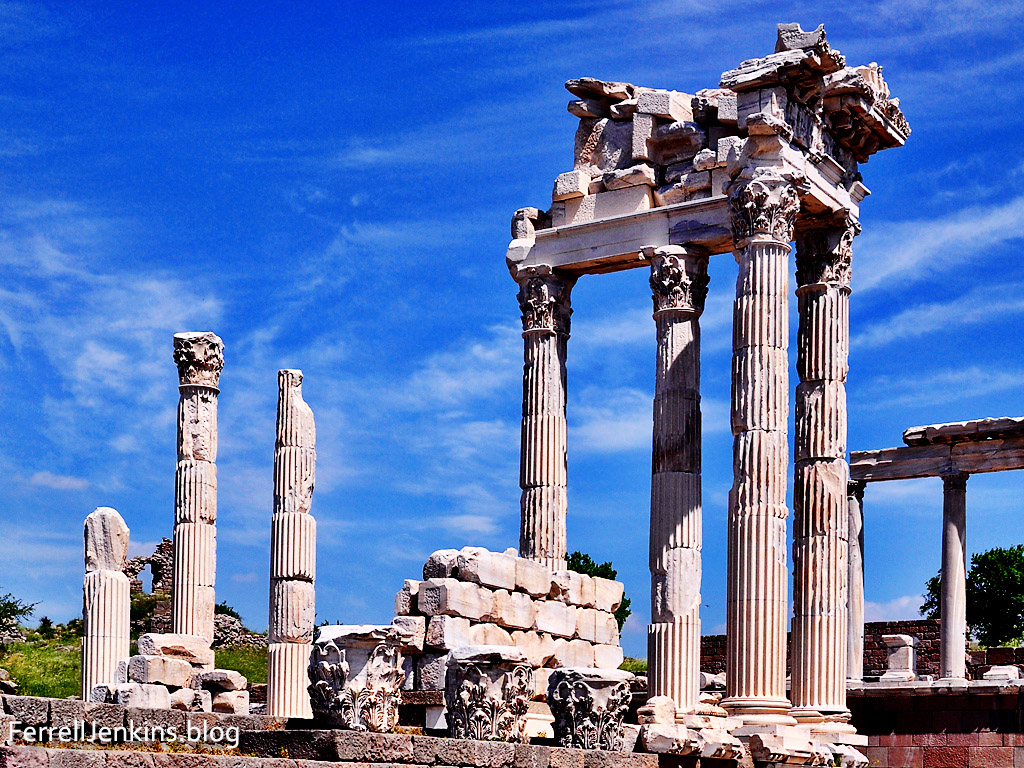

Mark and Lisa, thank you for your kind words. I think often of the kindness you showed to my mother when she was unable to do for herself. Glad you find the materials I have produced in your studies.
Ferrell, This was an excellent read mixed with some powerful pictures! Thank you for all these blogs we continue to look forward to all of them. Our fantastic vacation in Israel with you as our guide was a memory we will never forget or top. We still use your maps and guide book in our studies. We hope you and your wife have a healthy and happy holiday season, Lisa and I both send you our best wishes!
Mark and Lisa McMurray
>
The Bible really is timeless. Today we are living through the deification of a President. I was disappointed in Evangelicals, but I was thrown for a loop by my brethren falling for Trump as a savior. In fact I stopped going on FB because I was losing respect for people I have loved. It seems to me that politics is near top of the list in worldly activities. Jeff and I have often worked for local candidates we knew and have voted. But we never confused allegiance to God with fidelity to a political party. Thanks for your continuing efforts to fortify God’s people.